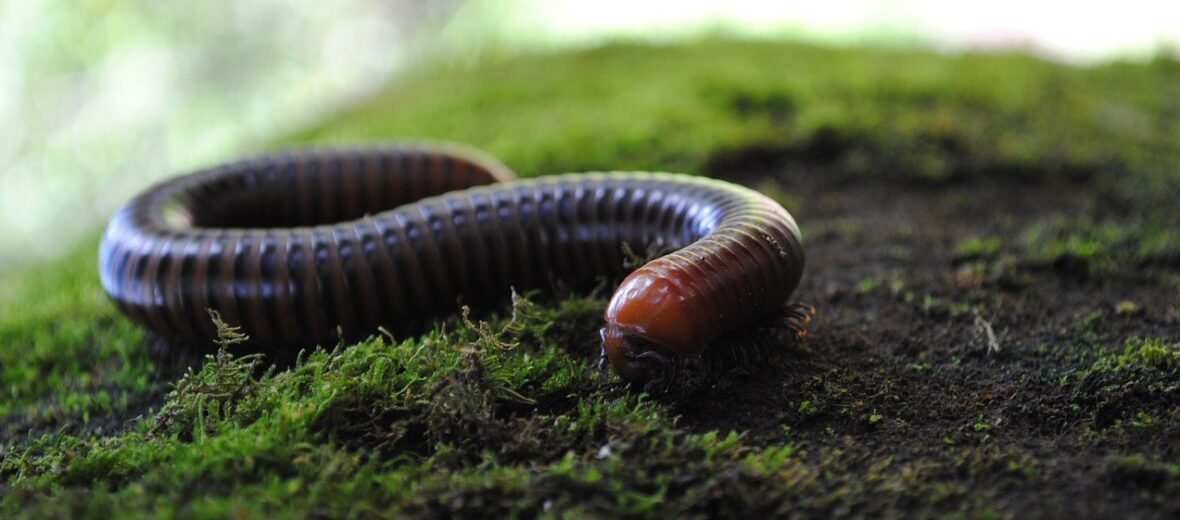
The millipede gets their name from the Latin mille, meaning “thousand”, and pes, meaning “foot”. They are found on all continents, sans Antarctica. A funny fact is that, until 2020, there were no documented millipedes with 1,000 legs. However, a species was discovered that has over 1,300 legs! The IUCN lists millipedes from Data Deficient to Critically Endangered, based on the species. I have worked with numerous species myself and they are indeed fascinating!
First the Stats…
Scientific name: Diplopoda
Weight: Up to .5 lb.
Length: Up to 13.2 inches
Lifespan: Up to 10 years
Now on to the Facts!
1.) There are about 12,000 documented species classified into 16 orders, and about 140 families of millipedes.
2.) Even though there are currently about 12,000 described species, it is estimated that there are approximately 15,000 – 80,000 total species out there. So much left to be discovered.
3.) Some other names for these creatures are milliped, thousand-legger, and diplopod.
4.) The vast majority are slow-moving detrivores (eat detritus – decaying leave and plant matter), however, others go after saplings and new plant growth, making them a nuisance or pest species.
5.) Millipedes are considered to be among the first animals to have colonized land during the Silurian period.
But wait, there’s more on the millipede!
6.) The name Diplopoda was labelled in 1844 by the French zoologist Henri Marie Ducrotay de Blainville.
7.) Diplopoda is a class within the arthropod subphylum Myriapoda, the myriapods, which also includes centipedes as well as the little-known pauropods.
Did you know…?
The largest known millipede was the Arthropleura, which grew to a whopping 6.5 feet in length and weighed in at an incredible 110 lbs.! They lived approximately 450 – 475 million years ago.
8.) Pauropods are considered to be the closest living relatives of millipedes.
9.) The majority of species reproduce via the male’s modified legs called gonopods, which transfer packets of sperm to females.
10.) What is the difference between millipedes and centipedes? The head alone is the main difference. Millipedes have short, elbowed antennae for searching the substrate, a pair of pronounced mandibles and a single pair of maxillae fused into a lip. Centipedes have elongated, threadlike antennae, a pair of small mandibles, 2 pairs of maxillae and a pair of large venom claws.
But wait, there’s still more on the millipede!
11.) Other differences between centipedes and millipedes are their legs. Millipedes have 2 pairs of legs per body segment, while centipedes have just 1 pair per segment.
12.) Another difference between the 2 are that millipedes are primarily detrivores, some are herbivores, and just a few are carnivores. While centipedes are primarily carnivorous.
Did you know…?
Some species of millipedes can produce poisonous compounds like alkaloids, benzoquinones, phenols, terpenoids, and even hydrogen cyanide.
13.) Lastly, but certainly not least, some millipedes are poisonous, while all centipedes are venomous.
14.) Females lay up to 300 eggs, based on the species, into soil or into a nest of dried faeces (poop).
15.) Some millipede species guard their nest, while others leave the eggs to their own devices.
But wait, there’s still a little more on the millipede!
16.) A wide variety of reptiles, amphibians, birds, mammals, and insects all prey on millipedes.
17.) Parasites also plague these creatures, like nematodes, phaeomyiid flies, and acanthocephalans.
Did you know…?
a couple of primates like capuchin monkeys and lemurs have been documented intentionally pestering millipedes in order to rub the chemicals on themselves to repel mosquitoes. Subsequently, they also get intoxicated off the chemicals in the process.
18.) As far as defenses go, some can only coil into a tight ball, protecting their legs and soft underbelly, while others emit a nasty smelling liquid secretion through microscopic holes called ozopores.
19.) Some of these chemicals are caustic and can even burn the exoskeleton of ants and other insect predators, as well as the skin and eyes of large predators.
20.) Commensal mites have been seen living on certain millipedes. They benefit the millipede by cleaning fungi and more off their exoskeleton.
Now a Short Millipede Video!
Be sure to share & comment below! Also, check out the Critter Science YouTube channel. Videos added regularly!
Want to suggest a critter for me to write about? Let me know here.
Some source material acquired from: Wikipedia & IUCN.



